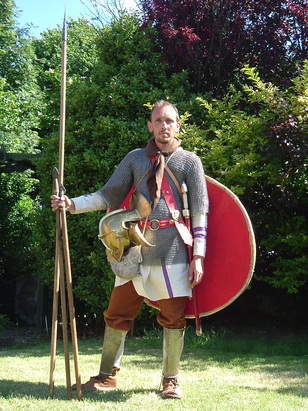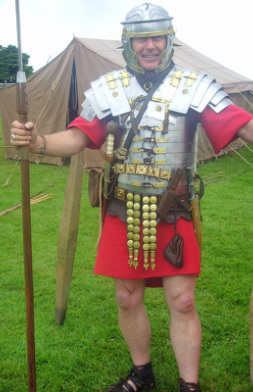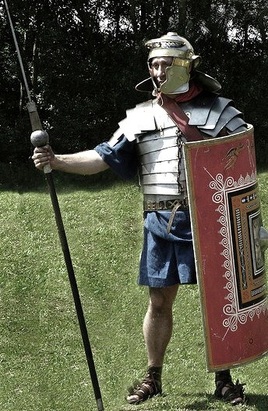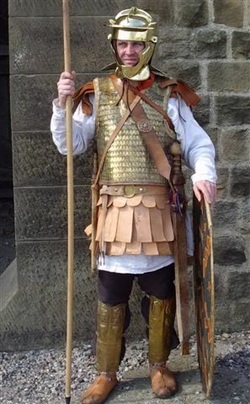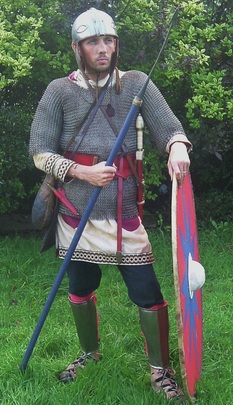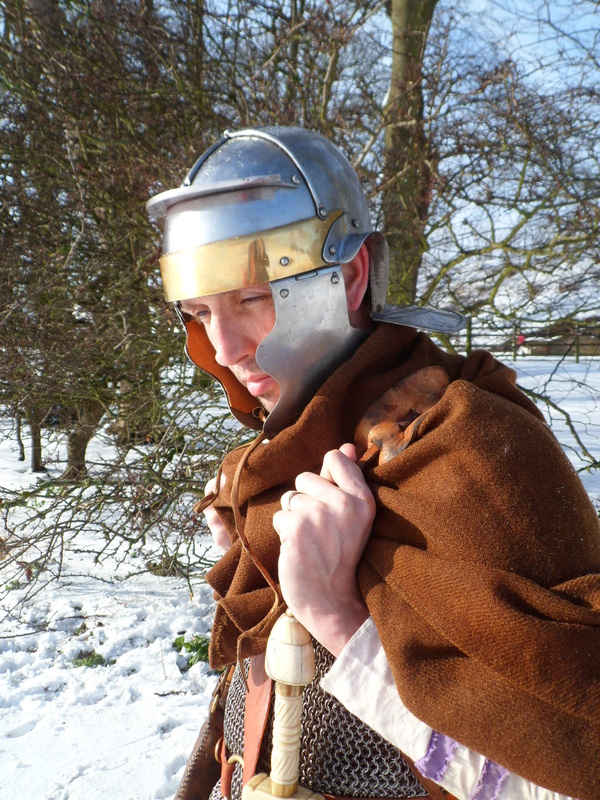ARMS AND ARMOUR
The weaponry, armour and equipment of the Roman legions was always changing. A soldier from the Punic Wars in 200 BC looked very different from one invading Britain in 43 AD and in turn he looked very different from a soldier of Constantine's army in 316 AD. Fashion, tactics and strategy meant the legions continually adapted and changed. Fortunatus and the other men in the Sixth Legion still retain many of the well-known items of kit, the rectangular shield, the throwing javelin (pilum) and the Roman helmet with wide neck guard. But it was in the reign of Septimus Severus that the legions began to radically change their appearance and equipment.
Use the tabs to read about the types of equipment that Fortunatus was able to use in 200 AD. There were several types of shield and helmet in use at the time for example, and a number of different types of armour. On different campaigns, at different forts and when part of different legions, Fortunatus will be using the weapons and armour that he can get hold of. He is forced to buy the equipment he uses from the legion, the price is deducted from his wages. This means he really looks after it! Often soldiers like Fortunatus scratch or hammer their names and even the century they belong to on their helmets and swords to prevent theft. It is common to paint one's name on one's own shield.
Use the tabs to read about the types of equipment that Fortunatus was able to use in 200 AD. There were several types of shield and helmet in use at the time for example, and a number of different types of armour. On different campaigns, at different forts and when part of different legions, Fortunatus will be using the weapons and armour that he can get hold of. He is forced to buy the equipment he uses from the legion, the price is deducted from his wages. This means he really looks after it! Often soldiers like Fortunatus scratch or hammer their names and even the century they belong to on their helmets and swords to prevent theft. It is common to paint one's name on one's own shield.
|
The Legionary: 200AD Left. Fortunatus is wearing a chainmail shirt over padding. He also wears leg armour (greaves) and a bronze cavalry helmet that the legions have just started wearing. The style is becoming popular. His shield is a large oval, also a new style that the legionaries and their commanders prefer for general combat. He is armed with a spatha (sword), two light-weight javelins (lancae) and a long thrusting spear (hasta). Spear fighting is a new tactic used in certain battles. |
How the Legionary Changed Through Time
|
1st century (around 80AD)
This soldier wears an Imperial-Gallic Type G helmet (a copy of one found at Hebron, Israel), his shortsword [gladius] is worn on the right. His armour is lorica segmentata and is worn along with a cingulum (decorated belt). He carries a curved shield and a pilum. This soldier wears civilian footwear and bracae (short trousers). |
2nd century (around 180AD)
This soldier wears a heavy Imperial-Italic H helmet, his sword is now a long sword [spatha] worn on a baldric on his right side. He still wears lorica segmentata, but no cingulum, his belt is open-work bronze in design. He still carries a curved scutum and his pilum is made more effective with a spherical weight. Long sleeves and trousers were becoming fashionable at this time. He wears caligae. |
|
3rd century (about 280AD)
This soldier is later than Fortunatus' own era. He wears a Heddernheim helmet, he continues to wear a longsword [spatha] on his right side. His armour is 'locked-scale' a new type of armour introduced in the 3rd century. Other types were still in use. He also wears a ring belt and boots that are enclosed. He carries a spear and a flat oval shield. Greaves protect his legs. |
4th century (about 380AD)
This soldier wears a cheap type of helmet now common called the 'Intercisa'. He wears chainmail armour, since segmentata was no longer used, but he still wears greaves. His belt is now very wide with metal parts. His spatha is worn from a narrow baldric. He carries a new type of pilum, the spiculum, but often carried a spear into combat instead. His shield is still the now common oval design introduced around 200AD. |
